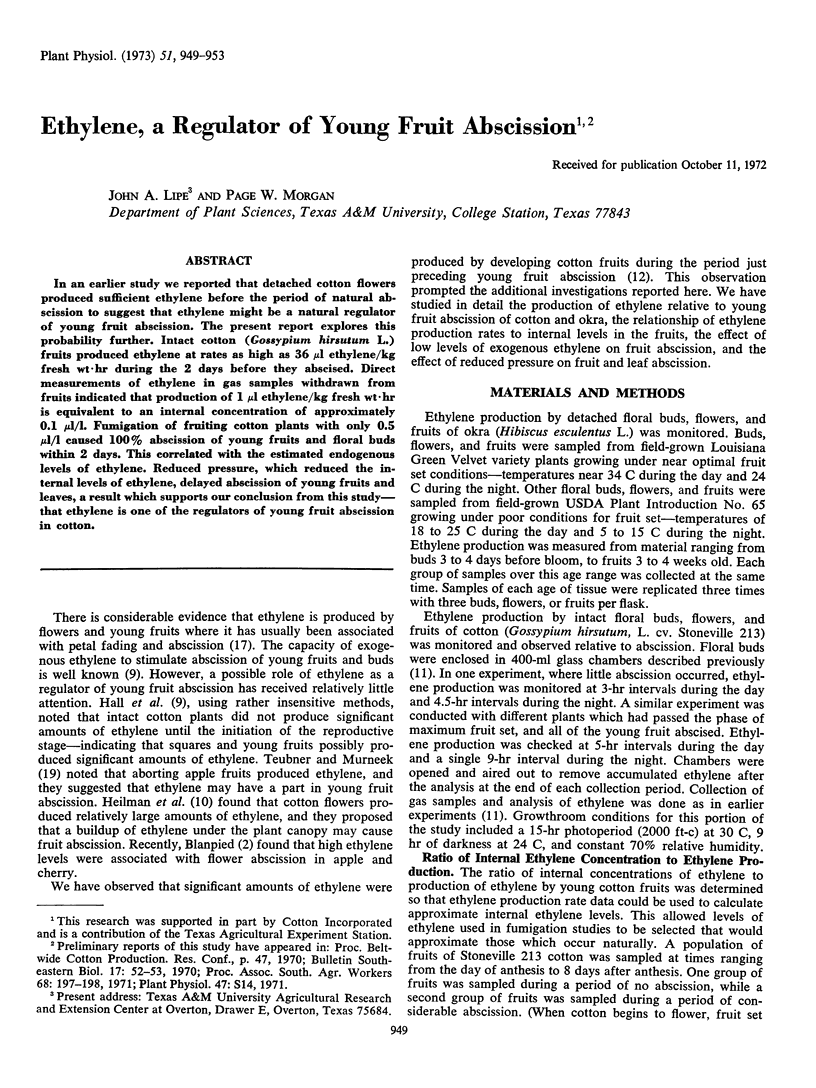Abstract
In an earlier study we reported that detached cotton flowers produced sufficient ethylene before the period of natural abscission to suggest that ethylene might be a natural regulator of young fruit abscission. The present report explores this probability further. Intact cotton (Gossypium hirsutum L.) fruits produced ethylene at rates as high as 36 μl ethylene/kg fresh wt·hr during the 2 days before they abscised. Direct measurements of ethylene in gas samples withdrawn from fruits indicated that production of 1 μl ethylene/kg fresh wt·hr is equivalent to an internal concentration of approximately 0.1 μl/l. Fumigation of fruiting cotton plants with only 0.5 μl/l caused 100% abscission of young fruits and floral buds within 2 days. This correlated with the estimated endogenous levels of ethylene. Reduced pressure, which reduced the internal levels of ethylene, delayed abscission of young fruits and leaves, a result which supports our conclusion from this study— that ethylene is one of the regulators of young fruit abscission in cotton.
Full text
PDF




Selected References
These references are in PubMed. This may not be the complete list of references from this article.
- Akamine E. K. Ethylene Production in Fading Vanda Orchid Blossoms. Science. 1963 Jun 14;140(3572):1217–1218. doi: 10.1126/science.140.3572.1217. [DOI] [PubMed] [Google Scholar]
- Burg S. P., Burg E. A. Fruit storage at subatmospheric pressures. Science. 1966 Jul 15;153(3733):314–315. doi: 10.1126/science.153.3733.314. [DOI] [PubMed] [Google Scholar]
- Burg S. P., Dijkman M. J. Ethylene and auxin participation in pollen induced fading of vanda orchid blossoms. Plant Physiol. 1967 Nov;42(11):1648–1650. doi: 10.1104/pp.42.11.1648. [DOI] [PMC free article] [PubMed] [Google Scholar]
- Cooper W. C., Rasmussen G. K., Rogers B. J., Reece P. C., Henry W. H. Control of abscission in agricultural crops and its physiological basis. Plant Physiol. 1968 Sep;43(9 Pt B):1560–1576. [PMC free article] [PubMed] [Google Scholar]
- Lipe J. A., Morgan P. W. Ethylene: Response of Fruit Dehiscence to CO(2) and Reduced Pressure. Plant Physiol. 1972 Dec;50(6):765–768. doi: 10.1104/pp.50.6.765. [DOI] [PMC free article] [PubMed] [Google Scholar]
- Lipe J. A., Morgan P. W. Ethylene: role in fruit abscission and dehiscence processes. Plant Physiol. 1972 Dec;50(6):759–764. doi: 10.1104/pp.50.6.759. [DOI] [PMC free article] [PubMed] [Google Scholar]
- McMichael B. L., Jordan W. R., Powell R. D. An effect of water stress on ethylene production by intact cotton petioles. Plant Physiol. 1972 Apr;49(4):658–660. doi: 10.1104/pp.49.4.658. [DOI] [PMC free article] [PubMed] [Google Scholar]
- Scholander P. F., Bradstreet E. D., Hemmingsen E. A., Hammel H. T. Sap Pressure in Vascular Plants: Negative hydrostatic pressure can be measured in plants. Science. 1965 Apr 16;148(3668):339–346. doi: 10.1126/science.148.3668.339. [DOI] [PubMed] [Google Scholar]


